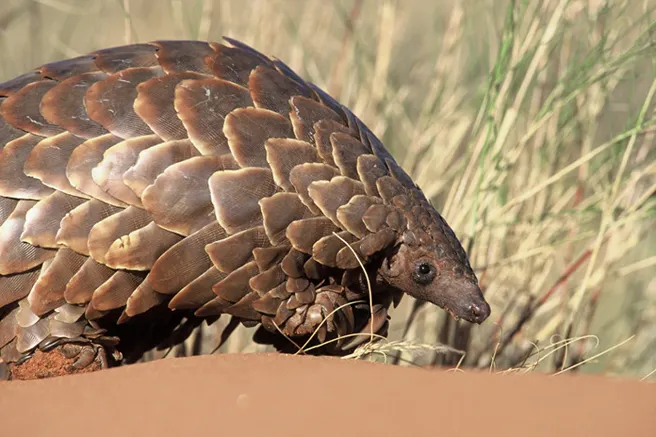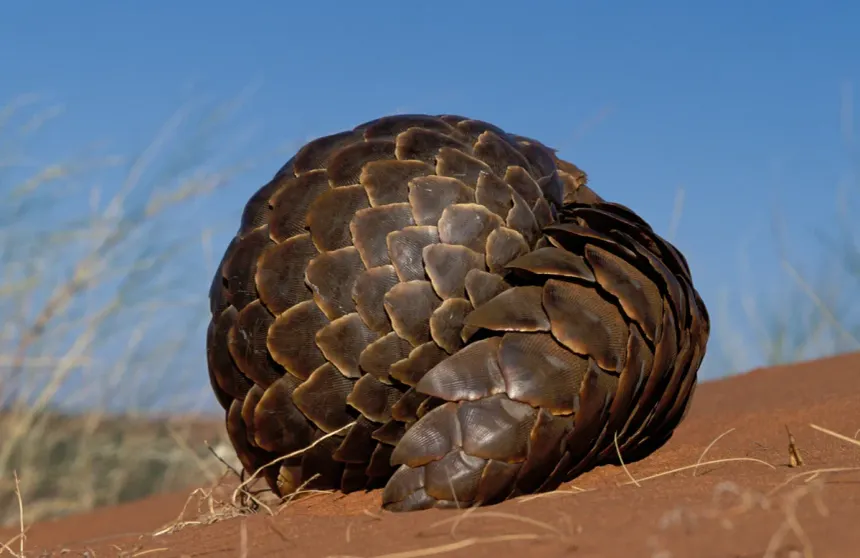10 Fascinating Facts About the Giant Pangolin

The giant pangolin (Smutsia gigantea) is the largest and perhaps most enigmatic member of the pangolin family—an ancient group of scale-covered mammals found in Africa and Asia. Despite its size and distinctive appearance, the giant pangolin remains elusive and under-researched, making it one of the most mysterious creatures in the wild.
Below are 10 interesting and detailed facts that offer insight into this remarkable and endangered animal:
1. It’s the Largest Pangolin Species in the World
The giant pangolin can weigh between 30 to 40 kilograms (66–88 pounds) and can measure up to 1.5 meters (5 feet) in length. This makes it the biggest of all eight pangolin species. Its heavy scales and muscular build give it an armored, prehistoric appearance.
2. Covered in Armor-Like Scales
Like all pangolins, the giant pangolin is covered in overlapping keratin scales—the same material that makes up human fingernails. These scales account for about 20% of its body weight and serve as a powerful defense mechanism. When threatened, it curls into a tight ball, protecting its soft underparts while the sharp-edged scales can slice into predators.
3. Native to Central and West Africa
Giant pangolins are found in tropical forests and savannahs across Central and West Africa, including countries like:
- Cameroon
- Congo
- Gabon
- Uganda
- Democratic Republic of Congo (DRC)
They prefer dense vegetation near water sources, where they can forage safely and find ample insect life.
4. Nocturnal and Solitary
Giant pangolins are strictly nocturnal, emerging from their burrows only at night to forage. They are also solitary, avoiding other pangolins except during the breeding season. Their behavior and movement patterns remain largely unknown due to their secretive nature.

5. Specialized Diet of Ants and Termites
Giant pangolins are myrmecophagous, meaning they feed almost exclusively on ants and termites. They have:
- No teeth
- Powerful front claws to break open termite mounds
- A long, sticky tongue (up to 70 cm or 27 inches) to slurp up insects
They can eat thousands of insects in a single night.
6. Excellent Diggers
Their strong forelimbs and claws make giant pangolins exceptional diggers. They create:
- Deep burrows for resting and nesting
- Tunnels that may extend for several meters underground
- Shelters near termite colonies to minimize travel
These burrows also provide shelter to other wildlife species, contributing to the ecosystem.
7. They Are Silent but Communicate Through Scent
While giant pangolins do not vocalize, they communicate through:
- Scent marking using anal scent glands
- Urine and feces to indicate territory
- Physical signals, such as curling into a ball or stomping
These behaviors are critical for maintaining territory and avoiding unwanted encounters.
8. Tragically Endangered Due to Poaching and Trafficking
The giant pangolin is highly endangered, primarily due to:
- Illegal hunting for bushmeat
- Trafficking of scales for traditional medicine (especially in Asia)
- Habitat loss from deforestation
Pangolins are the most trafficked mammals in the world, and the giant pangolin is particularly vulnerable due to its large size and slow reproductive rate.
9. Reproduction Is Rare and Poorly Understood
Very little is known about the breeding habits of giant pangolins. However:
- They likely mate once a year
- Gestation lasts about 5 months
- Females usually give birth to a single offspring
- Babies are born with soft, white scales that harden over time
- The young ride on their mother’s tail during early development
Their slow reproductive cycle makes population recovery difficult.
10. Conservation Efforts Are Underway—but Challenging
Because giant pangolins are so elusive, they’re difficult to study in the wild. However, some conservation measures include:
- Anti-poaching patrols in protected areas
- Habitat conservation projects in central Africa
- Awareness campaigns to reduce demand for pangolin scales and meat
- Tracking and research programs using GPS tagging to better understand their behavior
Internationally, they are protected under CITES Appendix I, which bans all international trade.

Conclusion: Nature’s Quiet Survivor at Risk
The giant pangolin is an extraordinary example of nature’s evolutionary creativity—an armored, insect-eating mammal with a prehistoric presence. Despite being relatively unknown to the general public, they are critical components of their ecosystems. Sadly, they face severe threats from human activity, and unless urgent conservation actions continue to expand, this mysterious species could vanish before we fully understand it.



